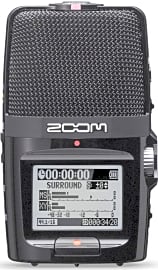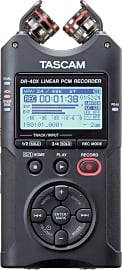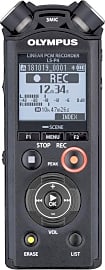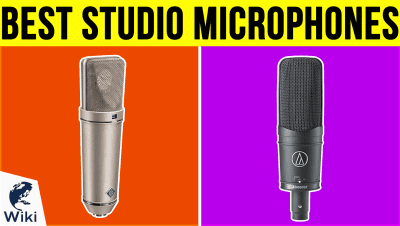The 10 Best Digital Audio Recorders

This wiki has been updated 40 times since it was first published in May of 2015. As technology has advanced, digital audio recorders have become more affordable and more versatile. These handheld devices can handle multi-track music recordings, on-the-go filmmaking, or just everyday dictation. Many boast useful features like noise cancellation, automatic sensitivity adjustment, and voice activation. We've included options to suit a variety of needs, budgets, and styles. When users buy our independently chosen editorial recommendations, we may earn commissions to help fund the Wiki.
Editor's Notes
December 04, 2020:
Digital audio recorders tend to advance in increments rather than leaps and bounds. Our latest update replaces obsolete models with newer versions, most of which see small but important improvements. The Zoom H4n Pro remains a favorite, as recent generations have added locking XLR inputs and higher-quality preamps. Like the Tascam DR-40X, it can handle multiple external microphones, making it a good pick for podcasters and musicians.
If you use your recorder more for interviews or meetings, a smaller handheld model like the Sony ICD-UX560 will do the job well. Audio recording doesn't have to be expensive — budget-friendly options like the Absetshop HD and Sony ICD-PX470 still have enough features for many buyers. Recording on a smartphone is always an option, but the mics are generally lower quality than those on a dedicated device. Consider an upgrade like the Shure MV88 for clearer sound.
April 02, 2019:
Given the fact that the Zoom H4n has become the go-to recorder for so many situations — from film sets to field recording sessions — it very easily climbed to the top of our list. Its size and feature set are hard to beat. Despite its recording quality, the Tascam DR-100 MkIII took a big hit, dropping a handful of spots from number one. That's mainly due to difficulties that arise from its preamps, which prevent that high-quality recording from tracking at high enough volumes at times. Elsewhere, the Zoom H1n got a nice little upgrade that kept it in the top three, but the Roland Studio got its own upgrade, and fell a few spots due to issue with its USB power feature. Also, the Olympus LS-14 skyrocketed in price recently, so we replaced it with the newer — and some might say better — LS-P2.
Special Honors
Hi-Q Pro For Android users, this app is a powerful and customizable way to record sound. It lets you choose your sample rate, bitrate, and recording format, and its interface is clean and easy to use. hiqrecorder.com
Just Press Record If you're recording on an iPhone, this app will simplify your workflow. It backs up your files to iCloud and offers automatic transcription as well as a variety of presets to optimize sound quality, openplanetsoftware.com
Stereo Recording In The Palm Of Your Hand
In the film, we get to see Travolta manipulating the latest mobile field recording equipment that 1980 had to offer, and it's amazing to see how far we've come since then.
In 1981, Brian De Palma took a fascinating film by Michelangelo Antonioni and remade it for American audiences. The original 1966 film, Blow Up, was about a shallow fashion photographer inadvertently capturing evidence of a murder in the background of one of his shots. It's the vaguest hint of evidence that only seems to look more vague as he increasingly blows up the image, seeing less as he works to see more.
De Palma's 1981 film, Blow Out, works on the same premise, but it's an audio recorder that captures the evidence instead of a camera, and the guy at the center of the drama is played by John Travolta before he became a caricature of himself.
That character, instead of being a fashion photographer, is a foley artist, a person who creates and recreates natural and unnatural sounds for use in movies. In the film, we get to see Travolta manipulating the latest mobile field recording equipment that 1980 had to offer, and it's amazing to see how far we've come since then.
The digital audio recorders on this list capture unbelievably clear sound, either from built-in stereo microphones, or through XLR and 1/4" inputs for microphones, MIDI outs, and more. They record, most often, to SD cards, so your storage space is only limited by how much you want to spend on it.
What's more, you can track multiple channels at a time–up to eight recording simultaneously with some models–and re-record on top of these to create multiple layers as you go. However many tracks you do record, there are limiter options, dual recording functions, and a variety of other tools to keep your audio from peaking and keep your signal clean and easy to edit.
If Travolta had had one of these puppies back in '81, well, it would have been a much shorter film.
Tracking Counts, So Count Your Tracks
When I was in bands throughout my middle school and high school days, we had 4-track and 8-track recorders that wrote to cassette tapes. They had enough inputs on them that we could cobble together a decent sounding demo tape to book ourselves some shows, and it always surprised club owners to meet the 13 and 14-year-olds they thought were at least around 18 when they listened to the music. Our ages might have gotten us kicked off of those bills, but the music–and the devices we used to track it–got us in the door.
If you're looking into digital recorders for music tracking, the more inputs you can work at the same time, the better.
It was important to us that we could track up to eight microphones at once, since a good drum sound requires at least three or four mics, and we had two guitars, a bass, and vocals to add on to that. If you're looking into digital recorders for music tracking, the more inputs you can work at the same time, the better.
Of course, you can get much smaller, more portable interfaces if you don't need as many tracks, still with the full suite of features.
On the features front, it's a good idea to pick your device based on your specific needs. Sound guys on film sets like the Zoom series quite a bit for its size, simplicity, and reliability, but I've had great times on set with Tascam products and their intuitive dual recording feature. With that feature, which easily toggles on and off on the bulk of their units–your audio gets recorded to two tracks, one of which can be set up to 12 dB quieter than the main audio. This way, if one of your actors screams in the middle of a take, you'll have it clean on the quieter channel.
Bigger isn't always better in this world, so ask yourself how many tracks you need, and what you need them to do to help guide you toward your best choice.
Is Anything Analogue Anymore?
Technically, digital audio recording started long before we had a digital medium on which to store the data. The first digital tape recorders of the 1970s took an incoming analogue audio signal and converted it to a digital binary, then recorded the information back onto an analogue tape. It was kind of like how a mama bird feeds a baby bird. So, you might ask, why bother with the conversion at all?
Well, by systematically assigning binary values to specific wavelengths, it would become much easier to scrub out undesirable frequencies and noises. Where tape captured all the intended and unintended sound making its way into a studio microphone, the digital medium could more easily filter out the sound of that passing train in the background, or the electric buzz of a poorly wired light fixture.
It was the compact disc introduced by Sony and Phillips in 1982 that offered recording artists a digital medium on which to print and store their recordings.
Advancements in computing and digital storage led to the smaller, more reliable storage formats we use today, even as the initial interface–the microphone and mixer–has remained more or less the same.















